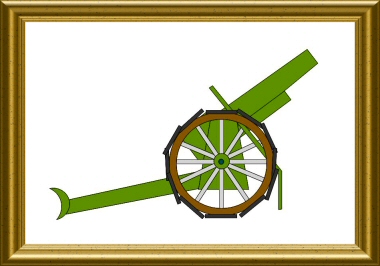|
Historic context :
While the experts of the APK German light artillery (Artillerie Prufungs Kommission - Artillery tests commission) denied the interest of the recoil recuperation systems until 1904, the heavy artillery experts adopted that progress as soon as 1899, requesting the start of the modernization of the 15 cm fieldhowitzer that was only dated 1893.
The design of the new weapon was initiated by the creation by Krupp of a 15cm V.H. 1899 ('V.H.' = 'VersuchsHaubitze' - research howitzer), that already included a hydro-spring recoil recuperation system, a longer carriage allowing easier transportation with the crew, amongst other imporvements. Tests of this weapon prototypes (built afterwards by 24 items from 1901) proved the succesful design but for the excessive weight (2335 kg).
Krupp took these re'marks into account and the resulting new gun, named '15 cm sFH 02' ('sFH' = schwere Feld Haubitze = Heavy field howitzer) after its adoption in 1903, achieved a lesser weight (close to 2000 kg) plus the integration of a transverse direction aiming system and an even longer carriage, while keeping the good ballistic properties of the prototype, including the 7450 m range.
The 15cm sFH 02 was therefore the very first regular gun of the German artillery to be equipped with a recoil recuperator, finally joining the worrld of modern artillery. This characteristic, associated with a new carriage with improved balance, a longer tube and a modern breech mechanism made tis howitzer a very good weapon. However, it was still missing a protection plate for the servants.
Its 42 kg projectiles gave a considerable destructive power, at a quite satisfactory range of 7.5 km. Its main issue was dictated by the conventional mid-length position of the trunnions on the recuperator system and the deign of the carriage : these characteristics prevented the servants to load the shells by the breech when the howitzer was firing with positive elevation angles, making it necessary to reposition the vbarrel in horizontal position between the shots, at the detrimental of the fire rate. This problem was lately solved with the 1913 model 15cm lFH 13 and the introduction of the famous Krupp concept of trunnions located at the breech level and balancing compensation systems.
The batteries of the foot artillery were equipped with 416 such howitzers at the beginning of the war. In November 1918, inventories still summed up 595 such guns.
The new version '15 cm lange sFH 13' appeared in 1913 induced the modernization of numerous existing '15cm sFH 02', with the modification of the frame and a longer tube (17 calibres for an initial 12). These modernized materials were called '15 cm sFH 13/02', and were produced to a quantity of about 1000 items.
A detailed story of German Heavy Field Artillery creation has been written by Ralph Lovett in this page that can be recommended : Development of the German 15cm.
|
Technical data :
- Complete description : 15cm heavy field howitzer M02
- Design year : 1902
- Calibre : 149.70 mm
- Weight in firing position : 2035 kg
- Weight for transportation : 2710 kg, one single load
- Tube length in calibres : 12.00 (total tube length) - 8 for the grooved part only
- Grooves : 36 progressive angle 6 to 13 degrees
- Projectile weight : 39 à 42 kg
- Initial speed : 325 m/s
- Fire rate :
- Range : 7450 m
- Elevation range : 0 to +42 degrees
- Direction range : 4 degrees total range
|


